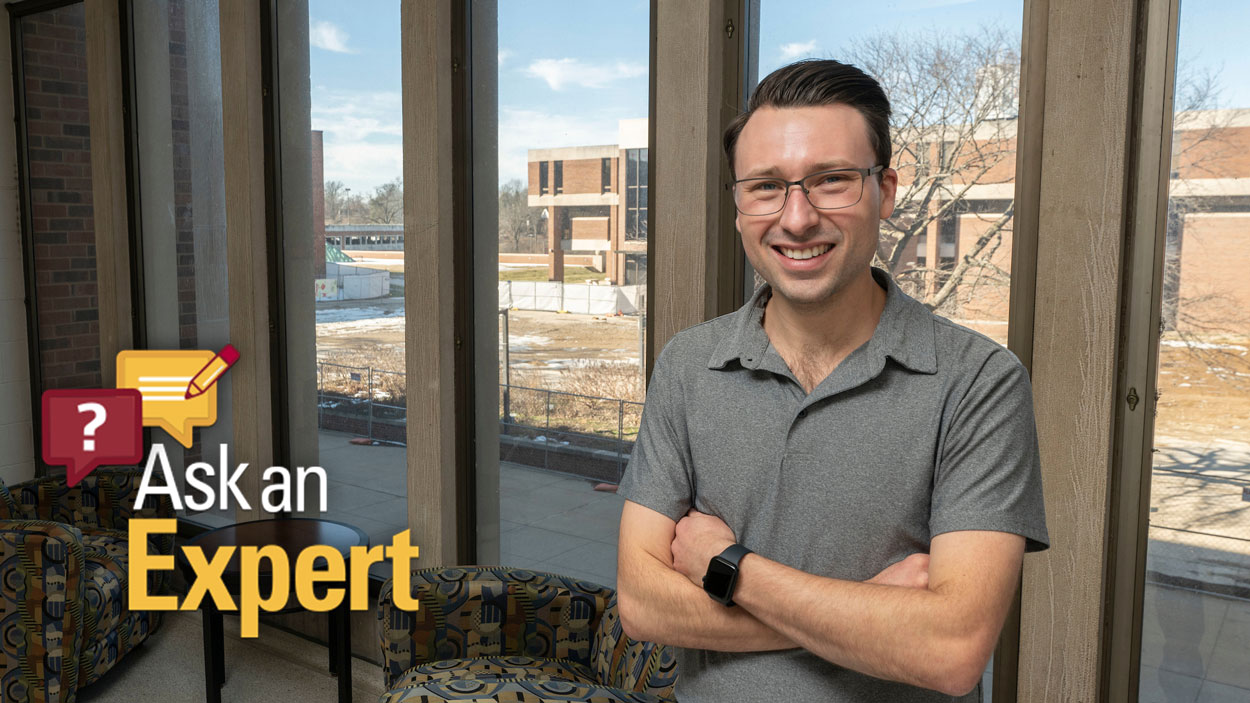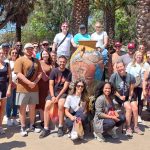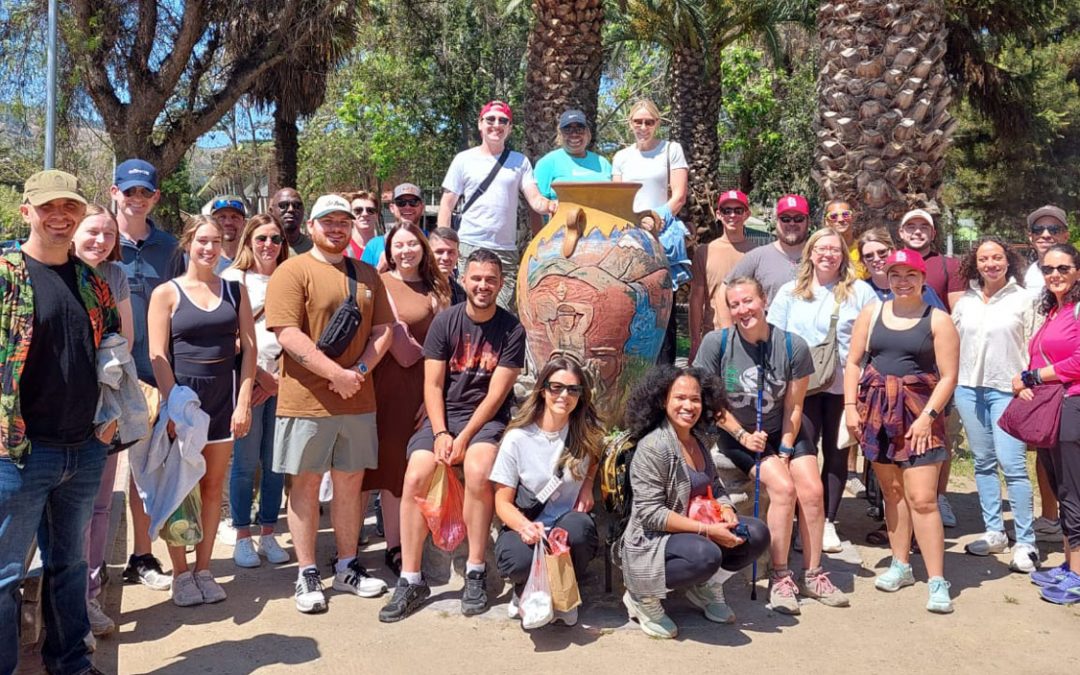
Brian Adler is an assistant teaching professor of sociology at the University of Missouri–St. Louis. His work focuses on the connections between housing, governance and society. He also teaches courses on sociology and urban communities. (Photo by Derik Holtmann)
Brian Adler lived car-free in St. Louis for several years – a decision that many in the metro area would find unthinkable.
During that time, Adler got around St. Louis by biking, walking and riding mass transit. He recalls being able to move about the city relatively smoothly compared to his hometown of Los Angeles. However, the experience also opened his eyes to the many obstacles pedestrians still face in St. Louis.
Apart from being an avid cyclist and urbanist, Adler is also an assistant teaching professor of sociology at the University of Missouri–St. Louis. His work often focuses on the intersection of public policy and urban communities.
Previously, Adler joined UMSL Daily to discuss revitalization and development in Downtown St. Louis. In the latest installment of Ask an Expert, UMSL Daily spoke with Adler about walkability, pedestrian infrastructure and the potential for improvements in Downtown St. Louis and beyond.
In Jeff Speck’s book “Walkable City,” he discusses the importance of pedestrian-friendly infrastructure to a successful downtown. Essentially, people need to feel safe walking or biking around. What can be done to improve the pedestrian experience in Downtown St. Louis?
Such a good question. There are so many low-hanging fruit opportunities that we’re leaving unaddressed. I talked to KMOX about this a couple of years ago, about the experience of walking and biking in St. Louis. This was something that attracted some attention because a lot of people can relate to not feeling safe, not just within our city, but within a host of cities because of our pedestrian infrastructure and biking infrastructure.
If I were to ask most of my friends or even ask myself, “Do I want to bike to Downtown St. Louis?” The answer is no. Until recently, there have been no protected bike lanes getting you anywhere close to Downtown. That means you’re sharing the road with cars, and that means that you’re trying to navigate uncertain environment rules where we still have some aggressive drivers, and if we’re being honest, sometimes some unpredictable bikers.
This creates a recipe for disaster. I have been the victim of a lot of verbal hostility when biking, even when I’m following all the rules to a T. That’s not particularly fun, even though I love biking, and so building more protected bike lanes is a key to making sure that we prevent that hostility, keep bikers out of the road with cars and also keep them away from pedestrians. This is the gold standard – the best practice that cities are doing – so getting those protected spaces is going to be a must.
With pedestrian walkability, we need to showcase that you can cross the street safely Downtown right by our center of government. Making sure that the painted strips on the crosswalks are not 20 years old, that people can actually see them when crossing to City Hall would be a wonderful first step. We need to make sure that all of the pedestrian timers and buttons actually work, that all of the crosswalks with their flashing timers actually turn on. These are core issues that we could fix within the next several months if we actually chose to do so.
Could you expand on the importance of protected bike lanes? Basically, green paint does not a bike lane make, right?
No, it does not. What you’ll typically find is that with a simple painted bike lane, drivers will not notice the paint. They will use the painted bike lanes as passing lanes, or frequently, they’re going to use them as parking lanes.
For instance, our most busy bike route in the entire City of St. Louis is along Tower Grove Avenue. Every single Saturday – and I mean every single Saturday – for the entire day, there are cars parked in that painted bike lane by the Botanical Garden and closer to Tower Grove Park, as well. That means on the days that people are going to be biking the most, their bike lane is consistently blocked. So, you have to swerve around parked cars, going into the traffic. These lanes do not work and create more chaos for bikers and drivers.
The idea with the protected bike lane is that we’re going to use bollards, whether plastic or metal, or curbs to make sure that car tires don’t drift into the bike lanes and the bikes don’t drift into the roads. This can be an expensive thing for cities to implement, unless they decide that it’s going to be a priority.
One thing that I think people will notice while they’re Downtown or really on other major roadways here is the width of the roads. Why is having an extremely wide four-lane road not optimal for pedestrians?
Yeah, it’s a great question, and one that I think when people really think about it, they’re going to recognize they’ve experienced these issues, too. These huge roadways are not something we would probably build in this day and age. These are products of urban planners like Harland Bartholomew and Robert Moses, early to mid-20th century figures who prioritized automobile access over absolutely everything else.
The idea was that you’d have folks able to drive in from their suburbs into downtowns, where they could park and not have to interact with anybody in between and then go head back home in the quickest manner possible. This was at the expense of pedestrian access and, of course, transit access as well. It’s the history of why we have those four- and six- and eight-lane roads in our downtowns.
Now, it’s bad for pedestrians because no matter when you start, when the walk sign says go, you’re going to be still crossing by the time it gets close to saying stop, right? These take a very long time to cross, and you are essentially relying on every single car user to recognize that you’re there and follow the road rules. But we all know not everybody follows the road rules, and so crossing these streets can be incredibly dangerous.
You’re at risk of cars turning right on red. You’re at risk of people turning left in front of you, and this is a consistent issue for me when I cross. It’s bad for even able-bodied people like myself, but if you were in a wheelchair or having any mobility issues whatsoever, you will not have enough time to cross or even navigate carefully through this environment to that end.
We have several highways that converge near Downtown. Now, those highways are typically four to six lanes. What I’ve noticed is that when you get off the highway and then you’re presented with a street that mimics a highway, people often then drive as if it’s a highway. Have you notice that as well?
Oh, no doubt. When we build wide roadways that are straight with lots and lots of room, you’re going to have people mimicking their habits from the highways within our urban areas. That means, when you’re crossing the street, you have to navigate people who are going well over the speed limit. This is common too, and there’s a social pressure because if you’re not speeding, well, you’re going to be the victim of some harassment and aggression by other road users.
There’s a phrase, “dangerous by design,” for some of our infrastructure around our Downtown and other regions because, by design, it’s extremely easy and almost encouraged to go extremely fast, regardless of those around you. I’m not suggesting that we need to make our roads curvaceous now. That’s pretty bad for urban design and our urban grids. That’s not what we need to do.
But if we were to narrow our roads, through careful road diets, we could see that we will not, in fact, negatively impact traffic times. At least the research on this is clear that road diets typically do not make your road experience longer, but it does make everyone’s experience safer when we have curb bump outs, when we reduce the number of lanes. This makes it safer and harder to speed as excessively as we did before.
There are also many one-way streets Downtown. Are these good for the pedestrian experience?
We should probably have more one-way streets. Part of this is colored by my experience visiting the diamond class of cities in North America. My wife and I spent the last summer in Montreal doing some of our research there, which was fantastic. It’s probably the safest city for pedestrians within North America – fantastic transit, fantastic bike lanes and fantastic roadways. It has incorporated, even outside of downtown, frequent usage of one-way streets.
There are some benefits when we do it right. First and foremost, it’s extremely obvious, if you’re a pedestrian, which way to look. You only have to check one direction, and if you’ve checked that, you’re good to go. Two, when we do one-way streets, we can also build them to be much more narrow than our two-way roadways. So, you have to cross a much shorter width of the streets, and you only have cars coming from one direction.
If you combine that with other gold standard types of planning for roads like bump outs, this is the safest kind of roadway infrastructure that we can have. If we ask ourselves, do we want our downtowns to be a hub for walkability and urbanism, I think that one-way streets are probably one of the best answers that we have to accommodate that.
Finally, let me touch on a hot topic when it comes to cars in urban spaces – parking. Urbanists are often critical of parking minimum requirements, especially in areas like Downtowns, because they prioritize vehicles over people. What’s your assessment of the current parking situation Downtown?
Well, put simply, we have way too much parking. There’s no doubt about that. Anytime you’re in Downtown, you’re going to find parking – maybe not within one city block of your destination. But any single day, any single evening, even on the weekend, that I’ve been Downtown, I have always found street parking. That’s without even looking at surface parking lots or other kinds of parking structures. That’s anecdotal experience, but I think if people truly ask themselves, “Is there parking at my destination or nearby?” The answer is currently always yes.
However, parking requirements are essentially the government mandating that there be excess parking. If there is a true market need for some certain amount of parking, there would be an incentive for developers to choose to build that parking on their own by the merits. Across most of the city, you’re going to find that more than one parking space is necessary per residential dwelling.
This is a level of insanity, because it’s requiring that, even in places where people aren’t driving, that you still have storage for cars there, right? There’s no reason for me to demand that there be a parking space to go visit my friend who lives in Downtown St. Louis. If this is going to be a hub of transit and walkability, then we shouldn’t want these people to be driving. We should want them to be, hopefully, taking those other cleaner forms of transportation.
Not only is a lot of parking being unused, but it’s also driving up housing costs for everyone. In my discussions with real estate developers and community development organizations, I’m regularly seeing the construction cost per parking space in a new parking garage reaching $40-50,000. Requiring that these parking spaces get built induces further car dependency upon our society writ large and the costs of parking get passed on to the consumer through increased rents.














